Cohen I.M., Kundu P.K. Fluid Mechanics
Подождите немного. Документ загружается.

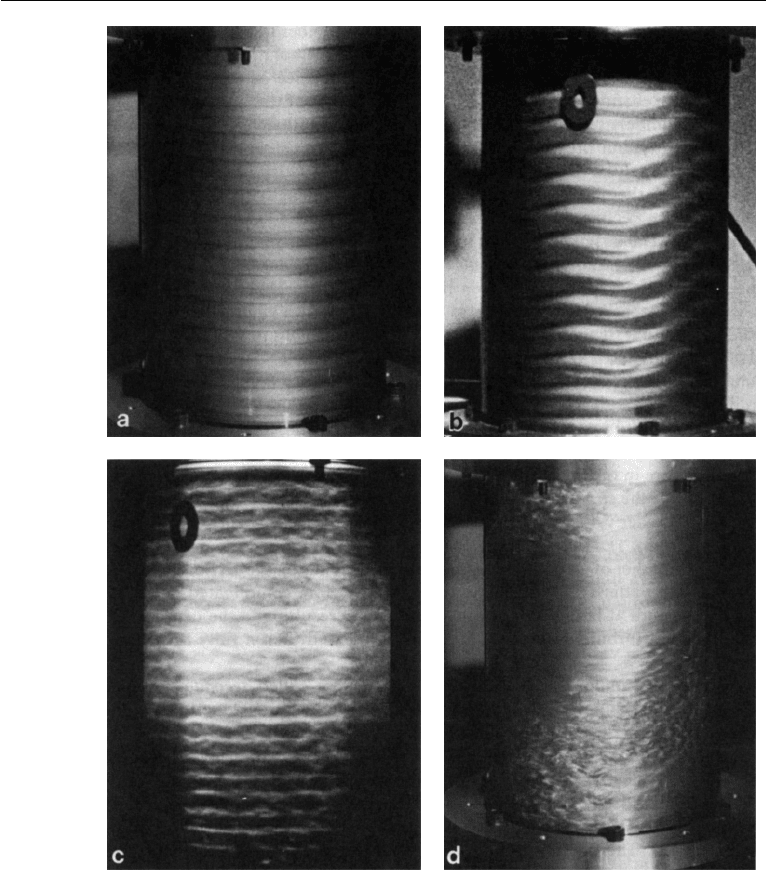
492 Instability
Figure 12.12 Instability of rotating Couette flow. Panels a, b, c, and d correspond to increasing Taylor
number. D. Coles, Journal of Fluid Mechanics 21: 385–425, 1965 and reprinted with the permission of
Cambridge University Press.
annulus. More complicated patterns of vortices result at a higher rates of rotation,
finally resulting in the occasional appearance of turbulent patches (Figure 12.12d),
and then a fully turbulent flow.
Phenomena analogous to the Taylor vortices are called secondary flows because
they are superposed on a primary flow (such as the Couette flow in the present case).
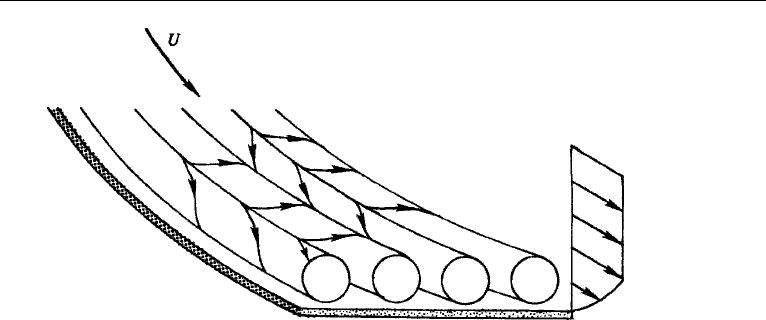
6. Kelvin–Helmholtz Instability 493
Figure 12.13 G¨ortler vortices in a boundary layer along a concave wall.
There are two other situations where a combination of curved streamlines (which
give rise to centrifugal forces) and viscosity result in instability and steady secondary
flows in the form of vortices. One is the flow through a curved channel, driven by
a pressure gradient. The other is the appearance of G¨ortler vortices in a bound-
ary layer flow along a concave wall (Figure 12.13). The possibility of secondary
flows signifies that the solutions of the Navier–Stokes equations are nonunique in
the sense that more than one steady solution is allowed under the same boundary
conditions. We can derive the form of the primary flow only if we exclude the sec-
ondary flow by appropriate assumptions. For example, we can derive the expression
(12.36) for Couette flow by assuming that U
r
= 0 and U
z
= 0, which rule out the
secondary flow.
6. Kelvin–Helmholtz Instability
Instability at the interface between two horizontal parallel streams of different
velocities and densities, with the heavier fluid at the bottom, is called the
Kelvin–Helmholtz instability. The name is also commonly used to describe the insta-
bility of the more general case where the variations of velocity and density are con-
tinuous and occur over a finite thickness. The more general case is discussed in the
following section.
Assume that the layers have infinite depth and that the interface has zero thickness.
Let U
1
and ρ
1
be the velocity and density of the basic state in the upper layer and U
2
and ρ
2
be those in the bottom layer (Figure 12.14). By Kelvin’s circulation theorem,
the perturbed flow must be irrotational in each layer because the motion develops from
an irrotational basic flow of uniform velocity in each layer. The flow can therefore be
described by a velocity potential that satisfies the Laplace equation. Let the variables
in the perturbed state be denoted by a tilde ( ˜). Then
∇
2
˜
φ
1
= 0, ∇
2
˜
φ
2
= 0. (12.42)
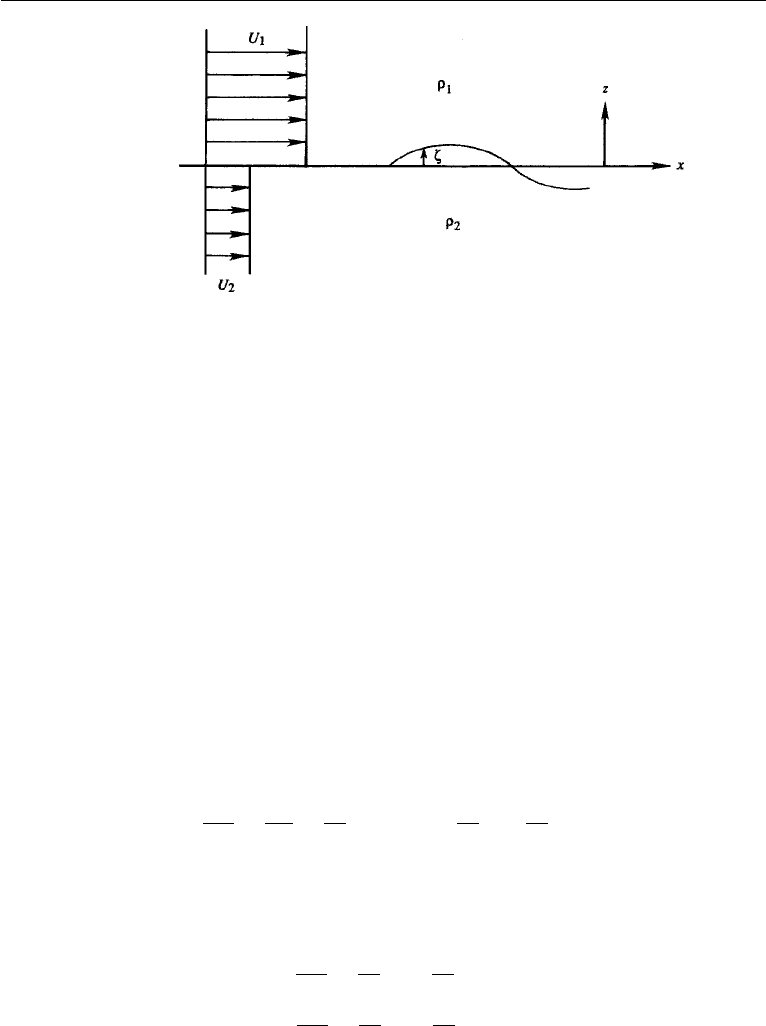
494 Instability
Figure 12.14 Discontinuous shear across a density interface.
The flow is decomposed into a basic state plus perturbations:
˜
φ
1
= U
1
x + φ
1
,
˜
φ
2
= U
2
x + φ
2
,
(12.43)
where the first terms on the right-hand side represent the basic flow of uniform streams.
Substitution into equation (12.42) gives the perturbation equations
∇
2
φ
1
= 0, ∇
2
φ
2
= 0, (12.44)
subject to
φ
1
→ 0asz →∞,
φ
2
→ 0asz →−∞.
(12.45)
As discussed in Chapter 7, there are kinematic and dynamic conditions to be
satisfied at the interface. The kinematic boundary condition is that the fluid particles
at the interface must move with the interface. Considering particles just above the
interface, this requires
∂φ
1
∂z
=
Dζ
Dt
=
∂ζ
∂t
+ (U
1
+ u
1
)
∂ζ
∂x
+ v
1
∂ζ
∂y
at z = ζ.
This condition can be linearized by applying it at z = 0 instead of at z = ζ and
by neglecting quadratic terms. Writing a similar equation for the lower layer, the
kinematic boundary conditions are
∂φ
1
∂z
=
∂ζ
∂t
+ U
1
∂ζ
∂x
at z = 0, (12.46)
∂φ
2
∂z
=
∂ζ
∂t
+ U
2
∂ζ
∂x
at z = 0. (12.47)
The dynamic boundary condition at the interface is that the pressure must be
continuous across the interface (if surface tension is neglected), requiring p
1
= p
2

6. Kelvin–Helmholtz Instability 495
at z = ζ . The unsteady Bernoulli equations are
∂
˜
φ
1
∂t
+
1
2
(∇
˜
φ
1
)
2
+
˜p
1
ρ
1
+ gz = C
1
,
∂
˜
φ
2
∂t
+
1
2
(∇
˜
φ
2
)
2
+
˜p
2
ρ
2
+ gz = C
2
.
(12.48)
In order that the pressure be continuous in the undisturbed state (P
1
= P
2
at z = 0),
the Bernoulli equation requires
ρ
1
1
2
U
2
1
− C
1
= ρ
2
1
2
U
2
2
− C
2
. (12.49)
Introducing the decomposition (12.43) into the Bernoulli equations (12.48), and
requiring ˜p
1
=˜p
2
at z = ζ , we obtain the following condition at the interface:
ρ
1
C
1
− ρ
1
∂φ
1
∂t
−
ρ
1
2
[(U
1
+ u
1
)
2
+ v
2
1
+ w
2
1
]−ρ
1
gζ
= ρ
2
C
2
− ρ
2
∂φ
2
∂t
−
ρ
2
2
[(U
2
+ u
2
)
2
+ v
2
2
+ w
2
2
]−ρ
2
gζ.
Subtracting the basic state condition (12.49) and neglecting nonlinear terms, we obtain
ρ
1
∂φ
1
∂t
+ U
1
∂φ
1
∂x
+ gζ
z=0
= ρ
2
∂φ
2
∂t
+ U
2
∂φ
2
∂x
+ gζ
z=0
. (12.50)
The perturbations therefore satisfy equation (12.44), and conditions (12.45),
(12.46), (12.47), and (12.50). Assume normal modes of the form
(ζ, φ
1
,φ
2
) = (
ˆ
ζ,
ˆ
φ
1
,
ˆ
φ
2
)e
ik(x−ct)
,
where k is real (and can be taken positive without loss of generality), but c = c
r
+ ic
i
is complex. The flow is unstable if there exists a positive c
i
. (Note that in the preceding
sections we assumed a time dependence of the form exp(σt), which is more convenient
when the instability appears in the form of convective cells.) Substitution of the normal
modes into the Laplace equations (12.44) requires solutions of the form
ˆ
φ
1
= Ae
−kz
,
ˆ
φ
2
= Be
kz
,
where solutions exponentially increasing from the interface are ignored because of
equation (12.45).
Now equations (12.46), (12.47), and (12.50) give three homogeneous linear alge-
braic equations for determining the three unknowns
ˆ
ζ , A, and B; solutions can

496 Instability
therefore exist only for certain values of c(k). The kinematic conditions (12.46)
and (12.47) give
A =−i(U
1
− c)
ˆ
ζ,
B = i(U
2
− c)
ˆ
ζ.
The Bernoulli equation (12.50) gives
ρ
1
[ik(U
1
− c)A + g
ˆ
ζ ]=ρ
2
[ik(U
2
− c)B + g
ˆ
ζ ].
Substituting for A and B, this gives the eigenvalue relation for c(k):
kρ
2
(U
2
− c)
2
+ kρ
1
(U
1
− c)
2
= g(ρ
2
− ρ
1
),
for which the solutions are
c =
ρ
2
U
2
+ ρ
1
U
1
ρ
2
+ ρ
1
±
g
k
ρ
2
− ρ
1
ρ
2
+ ρ
1
− ρ
1
ρ
2
U
1
− U
2
ρ
2
+ ρ
1
2
1/2
. (12.51)
It is seen that both solutions are neutrally stable (c real) as long as the second term
within the square root is smaller than the first; this gives the stable waves of the
system. However, there is a growing solution (c
i
> 0) if
g(ρ
2
2
− ρ
2
1
)<kρ
1
ρ
2
(U
1
− U
2
)
2
.
Equation (12.51) shows that for each growing solution there is a corresponding decay-
ing solution. As explained more fully in the following section, this happens because
the coefficients of the differential equation and the boundary conditions are all real.
Note also that the dispersion relation of free waves in an initial static medium, given
by Equation (7.105), is obtained from equation (12.51) by setting U
1
= U
2
= 0.
If U
1
= U
2
, then one can always find a large enough k that satisfies the require-
ment for instability. Because all wavelengths must be allowed in an instability analysis,
we can say that the flow is always unstable (to short waves) if U
1
= U
2
.
Consider now the flow of a homogeneous fluid (ρ
1
= ρ
2
) with a velocity dis-
continuity, which we can call a vortex sheet. Equation (12.51) gives
c =
1
2
(U
1
+ U
2
) ±
i
2
(U
1
− U
2
).
The vortex sheet is therefore always unstable to all wavelengths. It is also seen that
the unstable wave moves with a phase velocity equal to the average velocity of the
basic flow. This must be true from symmetry considerations. In a frame of refer-
ence moving with the average velocity, the basic flow is symmetric and the wave
therefore should have no preference between the positive and negative x directions
(Figure 12.15).
The Kelvin–Helmholtz instability is caused by the destabilizing effect of shear,
which overcomes the stabilizing effect of stratification. This kind of instability is easy
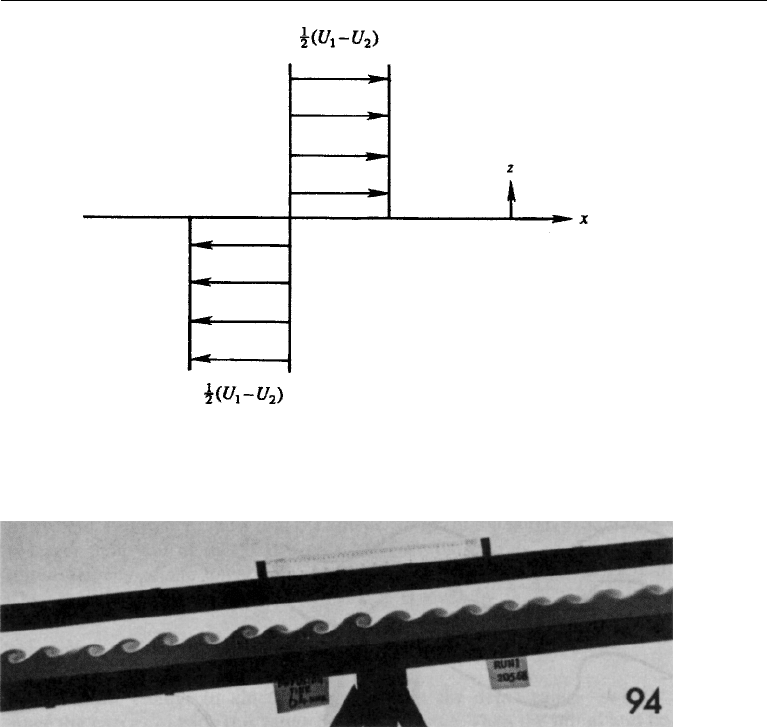
6. Kelvin–Helmholtz Instability 497
Figure 12.15 Background velocity field as seen by an observer moving with the average velocity
(U
1
+ U
2
)/2 of two layers.
Figure 12.16 Kelvin–Helmholtz instability generated by tilting a horizontal channel containing two
liquids of different densities. The lower layer is dyed. Mean flow in the lower layer is down the plane and
that in the upper layer is up the plane. S. A. Thorpe, Journal of Fluid Mechanics 46: 299–319, 1971 and
reprinted with the permission of Cambridge University Press.
to generate in the laboratory by filling a horizontal glass tube (of rectangular cross
section) containing two liquids of slightly different densities (one colored) and gently
tilting it. This starts a current in the lower layer down the plane and a current in the
upper layer up the plane. An example of instability generated in this manner is shown
in Figure 12.16.
Shear instability of stratified fluids is ubiquitous in the atmosphere and the ocean
and believed to be a major source of internal waves in them. Figure 12.17 is a striking
photograph of a cloud pattern, which is clearly due to the existence of high shear across
a sharp density gradient. Similar photographs of injected dye have been recorded in
oceanic thermoclines (Woods, 1969).
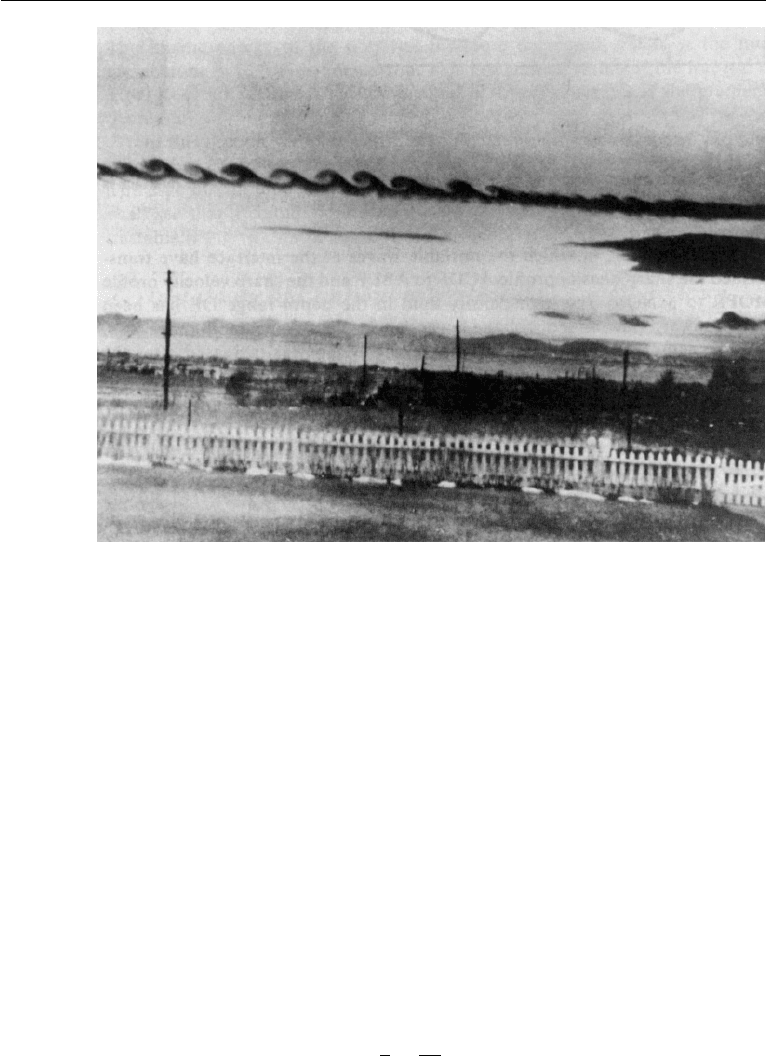
498 Instability
Figure 12.17 Billow cloud near Denver, Colorado. P. G. Drazin and W. H. Reid, Hydrodynamic Stability,
1981 and reprinted with the permission of Cambridge University Press.
Figures 12.16 and 12.17 show the advanced nonlinear stage of the instability in
which the interface is a rolled-up layer of vorticity. Such an observed evolution of the
interface is in agreement with results of numerical calculations in which the nonlinear
terms are retained (Figure 12.18).
The source of energy for generating the Kelvin–Helmholtz instability is derived
from the kinetic energy of the shear flow. The disturbances essentially smear out the
gradients until they cannot grow any longer. Figure 12.19 shows a typical behavior, in
which the unstable waves at the interface have transformed the sharp density profile
ACDF to ABEF and the sharp velocity profile MOPR to MNQR. The high-density
fluid in the depth range DE has been raised upward (and mixed with the lower-density
fluid in the depth range BC), which means that the potential energy of the system has
increased after the instability. The required energy has been drawn from the kinetic
energy of the basic field. It is easy to show that the kinetic energy of the initial profile
MOPR is larger than that of the final profile MNQR. To see this, assume that the
initial velocity of the lower layer is zero and that of the upper layer is U
1
. Then the
linear velocity profile after mixing is given by
U(z) = U
1
1
2
+
z
2h
− h z h.
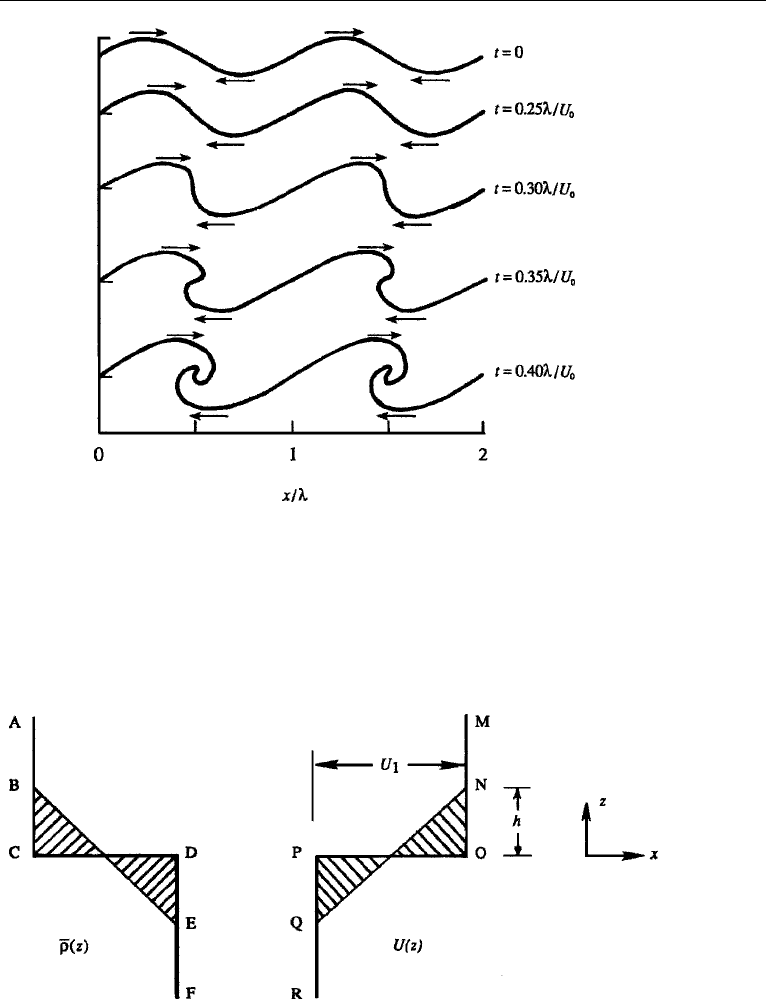
6. Kelvin–Helmholtz Instability 499
Figure 12.18 Nonlinear numerical calculation of the evolution of a vortex sheet that has been given a
small sinusoidal displacement of wavelength λ. The density difference across the interface is zero, and U
0
is the velocity difference across the sheet. J. S. Turner, Buoyancy Effects in Fluids, 1973 and reprinted with
the permission of Cambridge University Press.
Figure 12.19 Smearing out of sharp density and velocity profiles, resulting in an increase of potential
energy and a decrease of kinetic energy.

500 Instability
Consider the change in kinetic energy only in the depth range −h<z<h, as the
energy outside this range does not change. Then the initial and final kinetic energies
per unit width are
E
initial
=
ρ
2
U
2
1
h,
E
final
=
ρ
2
h
−h
U
2
(z) dz =
ρ
3
U
2
1
h.
The kinetic energy of the flow has therefore decreased, although the total momentum
(=
Udz) is unchanged. This is a general result: If the integral of U(z) does not
change, then the integral of U
2
(z) decreases if the gradients decrease.
In this section we have considered the case of a discontinuous variation across
an infinitely thin interface and shown that the flow is always unstable. The case of
continuous variation is considered in the following section. We shall see that a certain
condition must be satisfied in order for the flow to be unstable.
7. Instability of Continuously Stratified Parallel Flows
An instability of great geophysical importance is that of an inviscid stratified fluid
in horizontal parallel flow. If the density and velocity vary discontinuously across
an interface, the analysis in the preceding section shows that the flow is uncondi-
tionally unstable. Although only the discontinuous case was studied by Kelvin and
Helmholtz, the more general case of continuous distribution is also commonly called
the Kelvin–Helmholtz instability.
The problem has a long history. In 1915, Taylor, on the basis of his calcula-
tions with assumed distributions of velocity and density, conjectured that a gradient
Richardson number (to be defined shortly) must be less than
1
4
for instability. Other val-
ues of the critical Richardson number (ranging from 2 to
1
4
) were suggested by Prandtl,
Goldstein, Richardson, Synge, and Chandrasekhar. Finally, Miles (1961) was able to
prove Taylor’s conjecture, and Howard (1961) immediately and elegantly generalized
Miles’ proof. A short record of the history is given in Miles (1986). In this section we
shall prove the Richardson number criterion in the manner given by Howard.
Taylor–Goldstein Equation
Consider a horizontal parallel flow U(z)directed along the x-axis. The z-axis is taken
vertically upwards. The basic flow is in equilibrium with the undisturbed density field
¯ρ(z)and the basic pressure field P(z). We shall only consider two-dimensional distur-
bances on this basic state, assuming that they are more unstable than three-dimensional
disturbances; this is called Squires’ theorem and is demonstrated in Section 8 in
another context. The disturbed state has velocity, pressure, and density fields of
[U + u, 0,w],P+p, ¯ρ + ρ.
The continuity equation reduces to
∂u
∂x
+
∂w
∂z
= 0.

7. Instability of Continuously Stratified Parallel Flows 501
The disturbed velocity field is assumed to satisfy the Boussinesq equation
∂
∂t
(U
i
+ u
i
) + (U
j
+ u
j
)
∂
∂x
j
(U
i
+ u
i
) =−
g
ρ
0
( ¯ρ + ρ)δ
i3
−
1
ρ
0
∂
∂x
i
(P + p),
where the density variations are neglected except in the vertical equation of motion.
Here, ρ
0
is a reference density. The basic flow satisfies
0 =−
g ¯ρ
ρ
0
δ
i3
−
1
ρ
0
∂P
∂x
i
.
Subtracting the last two equations and dropping nonlinear terms, we obtain the per-
turbation equation of motion
∂u
i
∂t
+ u
j
∂U
i
∂x
j
+ U
j
∂u
i
∂x
j
=−
gρ
ρ
0
δ
i3
−
1
ρ
0
∂p
∂x
i
.
The i = 1 and i = 3 components of the preceding equation are
∂u
∂t
+ w
∂U
∂z
+ U
∂u
∂x
=−
1
ρ
0
∂p
∂x
,
∂w
∂t
+ U
∂w
∂x
=−
gρ
ρ
0
−
1
ρ
0
∂p
∂z
.
(12.52)
In the absence of diffusion the density is conserved along the motion, which
requires that D(density)/Dt = 0, or that
∂
∂t
( ¯ρ + ρ) + (U + u)
∂
∂x
( ¯ρ + ρ) + w
∂
∂z
( ¯ρ + ρ) = 0.
Keeping only the linear terms, and using the fact that ¯ρ is a function of z only, we
obtain
∂ρ
∂t
+ U
∂ρ
∂x
+ w
d ¯ρ
dz
= 0,
which can be written as
∂ρ
∂t
+ U
∂ρ
∂x
−
ρ
0
N
2
w
g
= 0, (12.53)
where we have defined
N
2
≡−
g
ρ
0
d ¯ρ
dz
.
N is the buoyancy frequency. The last term in equation (12.53) represents the density
change at a point due to the vertical advection of the basic density field across the
point.
